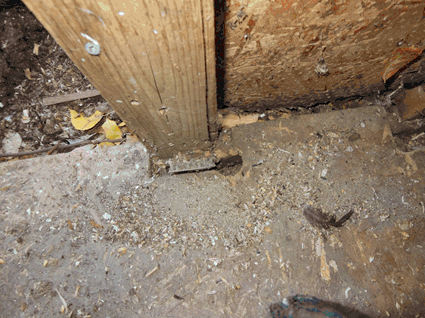| | Alberta's Rat Control Program Main Page
.
Burrows and Runways
- The cylindrical burrow entrance of a Norway rat in soil, straw or hay bales measures about 5 to 7.5 cm (2 to 3 inches). Unlike native rodents, the burrow entrance of a rat is clean of debris and excavated soil particles.
- Rats leave well-beaten trails about 5 centimetres (2 inches) wide from their nest areas to food and water sources. Rats often dig lengthy travel runs under objects such as bales, planks, granaries, plyboard, and even idle machinery to move from area to area.
 Rat hole with clean area around it, and ground is packed.
Rat hole with clean area around it, and ground is packed.
  Burrows and rat activity beside old grain bin and newer grain bin.
Burrows and rat activity beside old grain bin and newer grain bin.
 5 cm rat hole.
5 cm rat hole.
 Clean rat hole.
Clean rat hole.
 Rat runway in the grass.
Rat runway in the grass.
 Rat activity in a garbage pit.
Rat activity in a garbage pit.
Wall and Floor Holes
- The average size of the circular-shaped rat hole in walls and floors is 5 to 7.5 cm (2 to 3 inches) in diameter, but can be considerably larger, depending upon the material.
- Rats will make holes in walls or floors soon after invasion – wall holes are usually just inches above the floor. Holes in floors are generally close to walls or under-supporting skids or poles.
  Rat holes and rat activity. Gnawing
- Rats must chew continuously to wear down incisor teeth (front teeth) that grow an amazing 5 to 10 cm (2 to 4 inches) per year.
- Most often, rats will chew materials close by such as plywood, structural woodwork, plastic panelling, frozen ground and even concrete.
 Rat chewing and gnawing.
Rat chewing and gnawing.
Droppings
- Rats produce up to 25,000 droppings per year, so they can usually be detected if they have been present for even a short time.
- Rat droppings are blunt at both ends and the shape and size of an olive pit, measuring 1.25 to 1.5 cm (0.5 to 0.75 inches), and shiny black (Figure 5). Droppings fade in time and soon turn to grey-white.
 Rat droppings on a board.
Rat droppings on a board.
 Figure 5. Actual size of mice droppings (left) versus rat droppings (right).
Figure 5. Actual size of mice droppings (left) versus rat droppings (right).
Nests and Caches
- Norway rats are ground dwellers, so their nests and caches are built on or below ground level.
- The nest of a rat can consist of almost any material, usually food remains and other available items such as paper, straw, cardboard, rags or shredded plastic bags.
- Rats may horde and cache food, which may or may not be eaten.
Odors and Smudges
- The distinctive, musky odor of rats can be easily detected, particularly if rats are confined to a small area.
- The oily hair of a rat leaves noticeable smudge marks on trails or hole entrances. The combination of oily hair, dust and dirt results in obvious dark-stained surfaces.
|
|